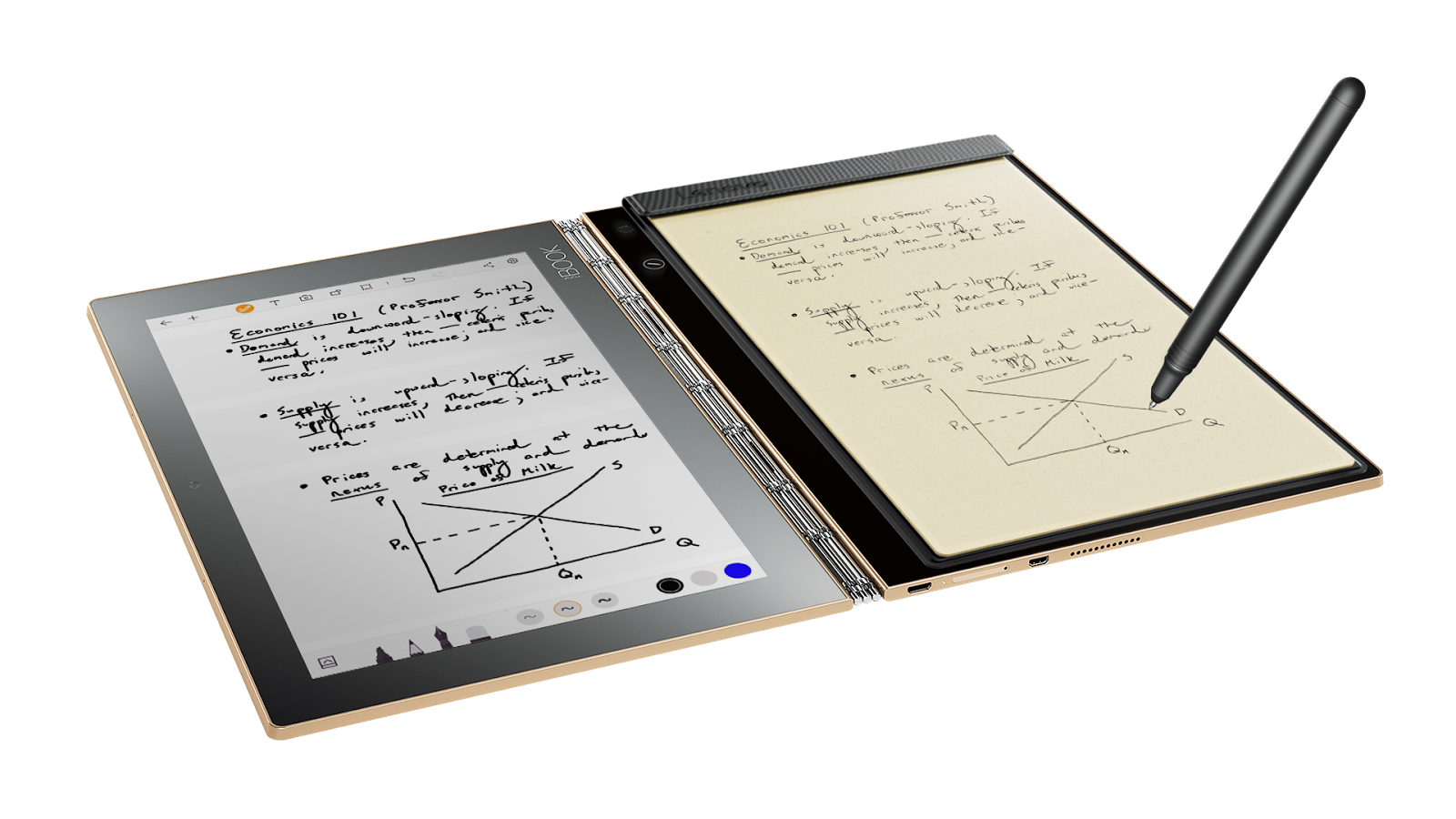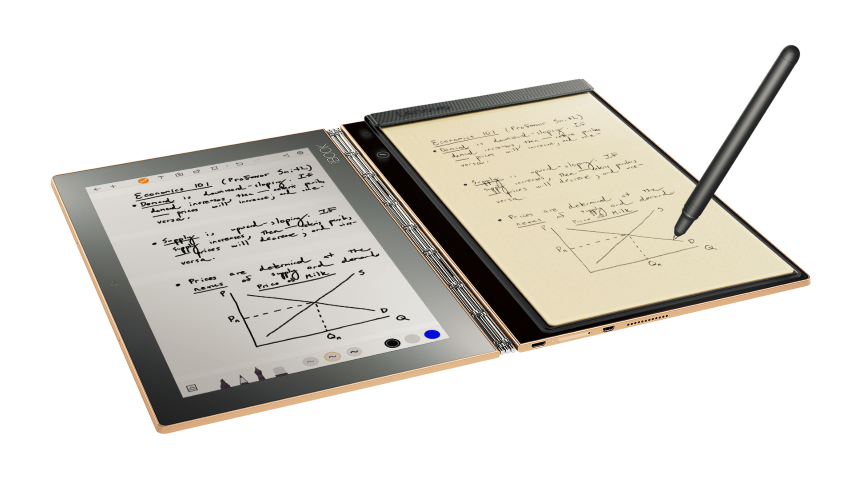Yoga Book: the first tablet with real notes and drafts
- Transfer
We have already reviewed an unusual tablet Yoga Book - the device turned out to be really original. Today, as promised, we will talk more about the main feature of the gadget - the Real Pen stylus, which allows you to create notes and sketches, just like in a regular notebook.
In March of this year, Jeff Meredith, CEO of Lenovo Android and the Chrome Computing Business Group, called the tablets boring. A whole class of devices needs to be shaken, and this can only be done in one way - to make models more suitable for specific tasks. Tablets are convenient for consuming content (watching movies, surfing the web and communicating on social networks), but not for creating something new.

Lenovo undertook to correct the situation, the result was Yoga Book - a distinctive “tablet” with the original mount of two halves. The device combines a familiar tablet and a full-fledged thin keyboard, as well as a stylus that completely mimics an ordinary pen - you can even write on paper. Unlike other tablets, Yoga Book allows you to create in the simplest and most natural way - as if on a regular sheet of paper.

The main goal of the engineering team was to achieve the maximum harmony of the gadget - only 9.9 mm. So there was “Halo Keyboard” - a keyboard without physical buttons. This allowed us to get rid of the excess thickness of the tablet. The developers realized that we can go even further, and added a converter that professional artists and designers use to transfer hand-drawn images to computers. The converter, as a rule, is used with a stylus or an electronic pen, but Lenovo sought a more natural feeling when working. As a result, together with Wacom feel IT technologies, a pen as close as possible to a conventional pen was developed.
When creating a Yoga Book, simplicity and, at the same time, unlimited functionality of a paper notebook were taken as the basis. Think: How do you usually work on a tablet? Take notes during the presentation, read articles on the Internet, watch the video. The first natural desire when you need to mark something is to take a simple notebook and pen, because it is still the most intuitive and easy way to write down information.
Working with Real Pen is as simple as using a regular pen, but with an important correction - the tablet instantly converts what you write on paper into digital format. Suppose you need to explain a working idea, and instead of entering long text, you can simply draw a chart or a freehand sketch and send it right away.
If it’s more convenient to type text, with one touch you switch to the keyboard. It appears only when necessary and is created taking into account the inconveniences that people experience when working with the touch keyboard - the Yoga Book implements a plausible imitation of physical buttons.

The principle of Yoga Book is the same as in professional solutions for designers. Drawing on the multifunction keyboard is displayed in a 1: 1 ratio on the main display. This gives you more options for drawing, a hand with a stylus does not obscure your sketches. The stylus is equipped with feedback, and it differs for different instruments. For example, you can feel the difference between using a pen, pencil or brush. The stylus recognizes 2048 degrees of pressure and 100 different degrees of inclination, which allows you to achieve maximum control and accuracy of a pencil or brush for drawing.
Lenovo took a non-standard approach to the development of the tablet and adopted a number of innovative solutions. Here's how it all works:
Lenovo engineers were able to put Gorilla Glass, an LCD panel, LED backlight (LGF), an electromagnetic resonance screen (EMR) and a number of system components in a 4 mm thick case. The keyboard pad is made of 0.55 mm anti-reflective glass. For convenience, when printing text, it is made rough. Under the glass is a touch panel that recognizes your touch. Behind it is a backlit membrane that simplifies printing in the dark. And at the very bottom is an EMR film - it recognizes stylus movements and pressing force.
The design of the device is designed so that all five layers function perfectly. Here they are:
The stylus uses electromagnetic induction technology. Waves follow from the sensor, receiving feedback from the stylus. These signals are processed by algorithms, which allows you to convert what is written into digital format.
Switching from keyboard to notebook: when the keyboard is not active, the surface becomes a notebook. By pressing the power button on the stylus, an EMR film comes into play, the layout with the backlight is deactivated. When the stylus is turned off, the handwriting mode is turned off and the familiar keyboard reappears.
Like paper: A multifunctional keyboard conveys the feel of paper when you write on it. Lenovo designers spent a year and a half and created more than a hundred prototypes of the surface with anti-reflective coating to achieve maximum realism.
Write like a regular pen: as planned, the stylus should have worked like a classic ink pen. The Lenovo team did not want to use the battery in the stylus. Moreover, the pen fully lives up to its name - Real Pen. She can write on plain paper, and on the touch panel. Developers thought out quick and easy ink refills. Lenovo created about two hundred samples before choosing the most suitable option.

Handwriting on screen:finally, Lenovo wanted to link AnyPen technology with EMR so that users could write on the display itself. Engineers opted for conductive polyformaldehyde (POM), which adjusts the touch panel and top screen for optimal signal to noise ratio. There were also several magnetic parts that could violate the stability of the signal and interfere with the operation of the digital converter, but it was possible to find the optimal solution. After many tests, Lenovo engineers achieved an excellent result.

Lenovo undertook to correct the situation, the result was Yoga Book - a distinctive “tablet” with the original mount of two halves. The device combines a familiar tablet and a full-fledged thin keyboard, as well as a stylus that completely mimics an ordinary pen - you can even write on paper. Unlike other tablets, Yoga Book allows you to create in the simplest and most natural way - as if on a regular sheet of paper.

The main goal of the engineering team was to achieve the maximum harmony of the gadget - only 9.9 mm. So there was “Halo Keyboard” - a keyboard without physical buttons. This allowed us to get rid of the excess thickness of the tablet. The developers realized that we can go even further, and added a converter that professional artists and designers use to transfer hand-drawn images to computers. The converter, as a rule, is used with a stylus or an electronic pen, but Lenovo sought a more natural feeling when working. As a result, together with Wacom feel IT technologies, a pen as close as possible to a conventional pen was developed.
When creating a Yoga Book, simplicity and, at the same time, unlimited functionality of a paper notebook were taken as the basis. Think: How do you usually work on a tablet? Take notes during the presentation, read articles on the Internet, watch the video. The first natural desire when you need to mark something is to take a simple notebook and pen, because it is still the most intuitive and easy way to write down information.
Working with Real Pen is as simple as using a regular pen, but with an important correction - the tablet instantly converts what you write on paper into digital format. Suppose you need to explain a working idea, and instead of entering long text, you can simply draw a chart or a freehand sketch and send it right away.
If it’s more convenient to type text, with one touch you switch to the keyboard. It appears only when necessary and is created taking into account the inconveniences that people experience when working with the touch keyboard - the Yoga Book implements a plausible imitation of physical buttons.

The principle of Yoga Book is the same as in professional solutions for designers. Drawing on the multifunction keyboard is displayed in a 1: 1 ratio on the main display. This gives you more options for drawing, a hand with a stylus does not obscure your sketches. The stylus is equipped with feedback, and it differs for different instruments. For example, you can feel the difference between using a pen, pencil or brush. The stylus recognizes 2048 degrees of pressure and 100 different degrees of inclination, which allows you to achieve maximum control and accuracy of a pencil or brush for drawing.
Lenovo took a non-standard approach to the development of the tablet and adopted a number of innovative solutions. Here's how it all works:
Lenovo engineers were able to put Gorilla Glass, an LCD panel, LED backlight (LGF), an electromagnetic resonance screen (EMR) and a number of system components in a 4 mm thick case. The keyboard pad is made of 0.55 mm anti-reflective glass. For convenience, when printing text, it is made rough. Under the glass is a touch panel that recognizes your touch. Behind it is a backlit membrane that simplifies printing in the dark. And at the very bottom is an EMR film - it recognizes stylus movements and pressing force.
The design of the device is designed so that all five layers function perfectly. Here they are:
First layer: Gorilla Glass with a thickness of 0.55 mm with anti-reflective coating (matte and fine-grained coating with a better stylus work and more convenient printing);
Second layer: keyboard touchpad. She recognizes your actions when typing text;
Third layer: LGF backlight;
Fourth layer: EMR film, which works with EMR technology to read movements while working with the stylus. Created with the participation of Wacom feel IT technologies;
Motherboard: processor, memory, battery and other components.
The stylus uses electromagnetic induction technology. Waves follow from the sensor, receiving feedback from the stylus. These signals are processed by algorithms, which allows you to convert what is written into digital format.
Switching from keyboard to notebook: when the keyboard is not active, the surface becomes a notebook. By pressing the power button on the stylus, an EMR film comes into play, the layout with the backlight is deactivated. When the stylus is turned off, the handwriting mode is turned off and the familiar keyboard reappears.
Like paper: A multifunctional keyboard conveys the feel of paper when you write on it. Lenovo designers spent a year and a half and created more than a hundred prototypes of the surface with anti-reflective coating to achieve maximum realism.
Write like a regular pen: as planned, the stylus should have worked like a classic ink pen. The Lenovo team did not want to use the battery in the stylus. Moreover, the pen fully lives up to its name - Real Pen. She can write on plain paper, and on the touch panel. Developers thought out quick and easy ink refills. Lenovo created about two hundred samples before choosing the most suitable option.

Handwriting on screen:finally, Lenovo wanted to link AnyPen technology with EMR so that users could write on the display itself. Engineers opted for conductive polyformaldehyde (POM), which adjusts the touch panel and top screen for optimal signal to noise ratio. There were also several magnetic parts that could violate the stability of the signal and interfere with the operation of the digital converter, but it was possible to find the optimal solution. After many tests, Lenovo engineers achieved an excellent result.
